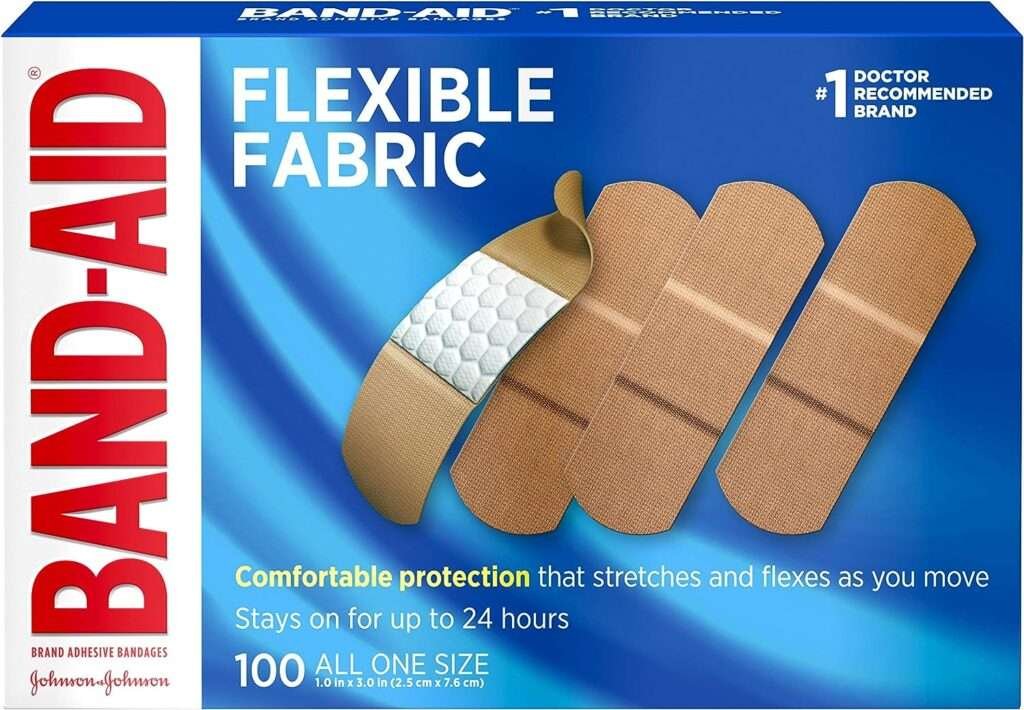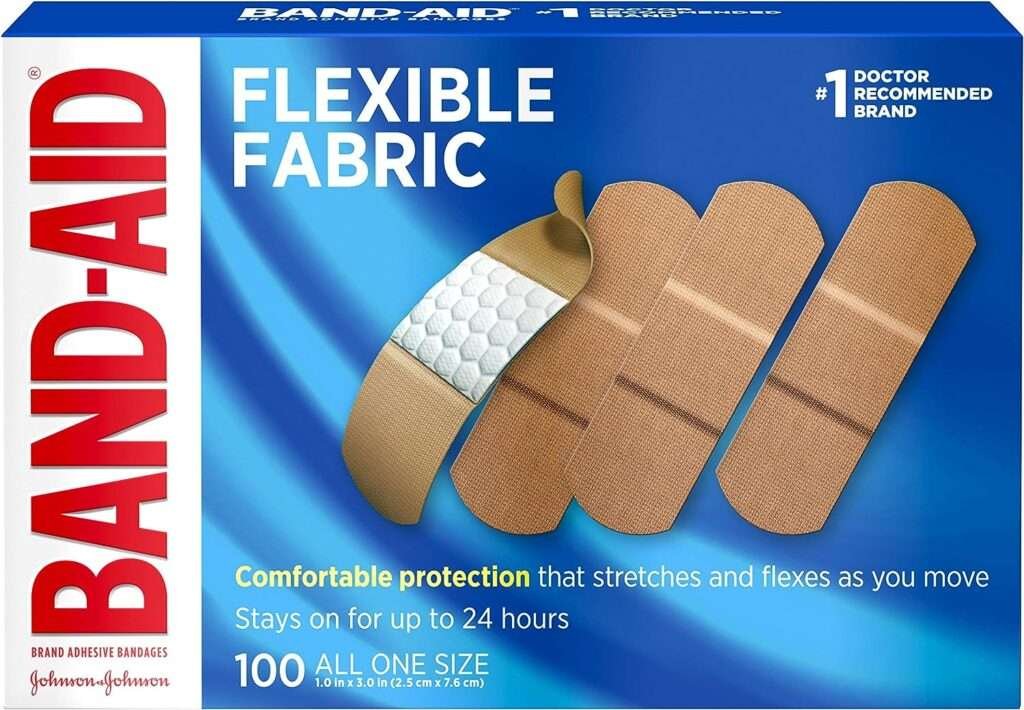
The mere mention of a band-aid box often brings the iconic brand Band-Aid, to our minds. These adhesive bandages’ have become a staple in households and first” aid kits worldwide. This article dives” deep into’ the Band-Aid Brand Flexible Fabric’ Adhesive’ Bandages, highlighting” their unique features, how to” use them, and their’ benefits.

Table of Contents
- FAQs
- Side Effects
- How to Use
- Benefits
- Real User Reviews
- Expert Opinions
- Routine
- Key Ingredients
- Varieties and Specialties
- What’s in a Band Aid Box?
- Maintenance and Storage
- Expert Tips
- Shopping Guide for Band-Aids
- Creative Uses of Band-Aids
- First Aid Training and Awareness
- A Final Dive into the Band Aid Box
- Final Verdict
- Conclusion

FAQs
1. What’s the difference between a clear band aid and the regular ones?
The clear band aid is designed to be nearly invisible on the skin, making it a discreet choice for visible areas. It serves the same protective purpose as the regular ones but offers an aesthetic advantage
2. I have a latex allergy. Are there band-aids suitable for me?
Absolutely. There are latex-free band-aids available. Ensure you pick up the latex free band aids variant when shopping. Always check the band aid box to be sure of its contents
3. Which band-aid should I use for a cut on my knuckle?
For joint areas like knuckles, the knuckle band aid is your best bet. It’s designed to flex with your joint” and offers protection without hindering movement.
4. Are there band-aids specifically designed for blisters?
Yes, the blister band aid is crafted to cushion” and protect blisters, especially those caused by shoes. They can’ offer relief and speed up healing.
5. I’ve seen many band aid sizes available. How do I choose the right one?
Band aid sizes vary to cater to different wound sizes. For small cuts, smaller band-aids are sufficient. For larger abrasions, big band aids might be more appropriate. Always ensure the bandage covers the entire wound.
6. How do I treat a wound on the tip of my finger?
There’s a specialized band aid for the tip of the finger. It’s designed to’ wrap around the fingertip, offering complete protection. They’re especially handy for those pesky paper cuts or minor nicks on the fingertip
7. I saw a band aid clipart in a first aid presentation. Is that an official design from the brand?
Band aid clipart often features in educational materials or designs. While some may be official designs, others could be creative representations by artists. Always check the source for authenticity.
8. Are there any significant differences between latex-free band-aids and the regular ones, aside from the latex?
In terms of function, both types offer the same level of protection. The key difference is the material: latex-free band-aids are designed to be safe for individuals with latex allergies.
9. I have a larger wound. Are regular band-aids suitable, or should I look for something more specific?
For larger wounds, big band aids are more suitable as they offer greater coverage. Ensure the bandage covers the entire wound to keep out contaminants.
10. I often see the terms “latex-free band-aids” and “latex free band aids” used interchangeably. Are they the same?
Yes, both terms refer to band-aids that do not contain latex. It’s crucial to check” the band aid box to ensure you’re getting the right type, especially if you or someone in your household has a latex allergy.

Side Effects
Most people use band-aids without any side effects. However, some might be allergic to adhesive, so it’s always a good idea” to look for latex-free band-aids, especially if you’re sensitive.
How to Use
- Clean the Wound: Always start by cleaning the wound to prevent infections.
- Choose the Right Size: From the knuckle band aid to the clear band aid, ensure the injury is fully covered.
- Secure the Bandage: Press down on the adhesive to ensure it sticks properly.
Benefits
- Protection: Band-aids provide a barrier against dirt and bacteria.
- Comfort: The flexible fabric moves with you. Especially the band aid for the tip of a finger ensures maximum comfort.
- Variety: With the knuckle band aid, big band aids, and the specialized blister band aid, there’s a solution for every injury.

Real User Reviews
- “I always have a band aid box handy. Especially appreciate the clear band aid variant as it’s hardly noticeable!”
- “The band aid for the tip of my finger was’ a lifesaver” when I had a paper cut!”
Expert Opinions
Medical professionals often recommend having a variety of band-aid sizes in your first aid box. The availability of latex-free band-aids ensures everyone, even those with allergies, can use them safely.
Routine
For the best wound care:
- Cleanse
- Apply a band-aid, whether it’s a knuckle band aid or a clear band aid.
- Replace as needed.

Key Ingredients
While most think of the adhesive and fabric, it’s worth noting that the blister band aid comes with added cushioning. Always check if you’re using latex-free band-aids to avoid potential allergies.
Varieties and Specialties
While most are familiar with the basic adhesive bandages, the Band-Aid brand offers a plethora of options tailored to specific needs:
- Band aid clipart: An illustrative tool often used for educational or design purposes, reminding us of the iconic nature of this brand.
- Knuckle band aid: Designed with a unique shape to cover and protect injuries on the joint, ensuring that movement doesn’t interfere with healing.
- Latex-free band-aids: A must-have for those with latex sensitivities. Always check the band aid box details to ensure it’s the latex-free variant you’re grabbing.
- Clear band aid: When discretion is paramount. It’s almost invisible on the skin, making it a favorite for facial injuries or any spot you’d rather keep unnoticeable.
- Band aid sizes: The brand offers various sizes, from tiny ones for those pesky paper cuts to big band aids covering larger scrapes.
- Latex free band aids: Again, it can’t be emphasized enough how important these are for allergy-prone individuals.
- Big band aids: For when regular sizes just won’t cut it. These offer more” coverage and ensure larger wounds are adequately protected.
- Band aid for the tip of the finger: An oddly specific but incredibly useful type. They wrap around” the fingertip, providing 360-degree protection.
- Blister band aid: These are cushioned to protect against friction, making them perfect for those new shoes that haven’t been broken in yet.

What’s in a Band Aid Box?
Opening a band aid box is like unveiling a toolkit for minor injuries. Here’s what you might find:
- An assortment of band aid sizes.
- Specialty band-aids like the blister band aid or the knuckle band aid.
- Instructions on” how to use” them most effectively.
- Often, the band aid box will have a clear indication if the bandages inside are latex-free band-aids, so always check before use.
- Apply a band-aid, whether it’s a knuckle band aid or a clear band aid.
Maintenance and Storage
For maximum efficacy, store your band aid box in a cool, dry place. This ensures the adhesive on the clear band aid and other types remains sticky and effective. Also, periodically check and replenish your band aid box to ensure you’re never caught without the band aid sizes you need.
Expert Tips
- Using the right band aid for the right wound type (like a blister band aid for blisters) can speed up healing.
- Always check for the “latex-free” label if you’re allergic. Both “latex-free band-aids” and “latex free band aids” mean the same, but ensuring there’s no confusion is crucial.
- For fingertip injuries, the band aid for the tip of the finger is unmatched in protection.

Shopping Guide for Band-Aids
Navigating the Band-Aid aisle can seem overwhelming, given the array of choices. Here’s how to” make the most informed’ decision:
- Identify your need: Before reaching for that band aid box, think about your specific requirements. Do you need a clear band aid for discrete protection, or are you after a specialized blister band aid to cushion and protect a sore spot?
- Sizing matters: Band aid sizes vary considerably. While big band aids are great for significant abrasions, they might be overkill for a small cut. Conversely, a tiny bandage might not offer adequate coverage for a larger injury.
- Specialty band-aids: Some injuries require specialized care. A knuckle band aid, for instance, is designed to flex with the joint. And if you’ve ever tried using a regular adhesive on a fingertip, you’ll understand the genius behind the band aid for the tip of the finger.
- For the allergy-prone: Latex-free band-aids are a godsend for those with allergies. Always ensure you’re picking up a box of latex free band aids if you or someone in your household has a sensitivity.
Creative Uses of Band-Aids
While their primary use is wound care, these adhesive strips have found their way into various innovative applications:
- Band aid clipart: Artists, educators, and designers often use band aid clipart to convey ideas of healing, care, or just to add a touch of whimsy to their projects.
- Shoe Blisters: Before a blister even forms, if a shoe is causing discomfort, promptly applying a blister band aid can prevent a painful situation.

First Aid Training and Awareness
One of the first things taught in basic first aid courses is the correct way to use band-aids:
- Assessment: Not every injury needs a band-aid. Sometimes, letting a minor scratch breathe is best. However, if there’s a risk of dirt” or contaminants, it’s wise to cover it’ up.
- Choosing the Right Band-Aid: The array of band aid sizes and types, from the clear band aid to the knuckle band aid, allows for tailored wound care.
- Application: Once you’ve cleaned and dried the wound, gently apply the bandage, ensuring there are no creases. Whether you’re using a knuckle band aid, a clear band aid, or a band aid for the tip of the finger, smooth application is key.
- Allergy Watch: Latex-free band-aids should be a staple in public spaces like schools or offices to ensure everyone’s safety.

A Final Dive into the Band Aid Box
Upon opening a band aid box, it’s evident the brand has given deep thought to our wound care needs. Inside, you’ll find a variety of band aid sizes, from those catering to minor abrasions to big band aids” that cover more ground. Specialized offerings, like the blister band aid or” the band aid for” the tip of the finger, showcase the brand’s dedication to comprehensive care.
Final Verdict
Band-Aid Brand Flexible” Fabric Adhesive Bandages are versatile, comfortable, and an essential part of wound care. Whether you’re looking for a band aid clipart” for educational purposes or searching for” big band aids for larger wounds, this brand has got you covered.
Conclusion (Revisited)
Band-Aid brand’s rich variety, from the clear band aid to the specialized knuckle band aid, ensures that all our minor wound care needs are covered. With the added assurance of latex-free band-aids for allergy-prone individuals, it truly is a brand that thinks of everyone. Whether you’re checking a band-aid clipart for a project or placing a blister band aid on a sore foot, trust in Band-Aid to deliver comfort and protection.
Apply a band-aid, whether it’s a knuckle band aid or a clear band aid.
.
